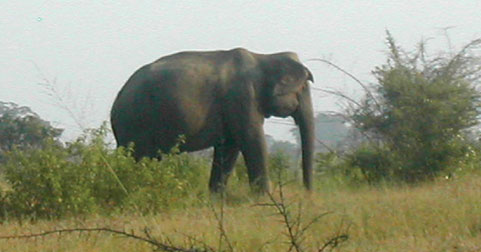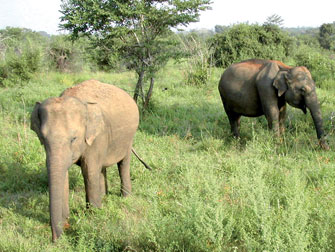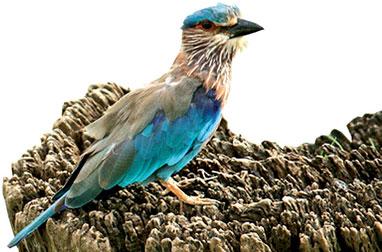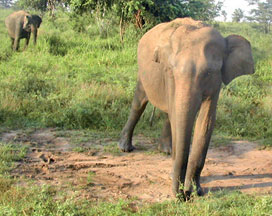Living treasures of Udawalawe
by Janani AMARASEKARA
 After a four-hour drive from Colombo via Rathnapura, Pelmadulla and
Udawalawe junction, you can reach the sixth largest animal sanctuary of
Sri Lanka - the Udawalawe National Park. The park encloses an area of
30,821 hectares, and is bordered by the Southern and Uva provinces. When
the Udawalawe reservoir was constructed, many animals lost their natural
habitats. As a result, in 1972 this area was declared as a national
park. After a four-hour drive from Colombo via Rathnapura, Pelmadulla and
Udawalawe junction, you can reach the sixth largest animal sanctuary of
Sri Lanka - the Udawalawe National Park. The park encloses an area of
30,821 hectares, and is bordered by the Southern and Uva provinces. When
the Udawalawe reservoir was constructed, many animals lost their natural
habitats. As a result, in 1972 this area was declared as a national
park.
Another reason for Udawalawe to be considered for elephant
reservation, was to ensure the availability of water, from the Udawalwe
reservoir and Mau Ara basin, even in the driest periods. This park is a
popular travel destination among locals as well as foreigners, and is
open throughout the year.
Elephants are a common sight in Udawalawe. They can be observed at
any time of the day. Rehabilitated elephants from the Elephant transit
home are released primarily to the Park. Besides the elephants, recent
investigations have recorded 21 species of fish, 12 species of
amphibians, 18 species of snakes, 15 species of tetra pod reptiles, 184
species of birds and 39 species of mammals. "Excepting for bears almost
all varieties of dry zone animals live here," a volunteer guard of the
park, L.D. Mahesh said. There are many water buffaloes all around the
park. Spotted and barking deer, jackal, wild boar, and grey and striped
necked mongoose are some of the fascinating animals found in the park.
It is said that leopards, jungle and fishing cats have been spotted;
however, their sightings are very rare.
 "The park is famous for birds as well," said Mahesh. "The numbers of
bird varieties are almost equal to Kumana, a bird lover can find many
birds here, " he added. The Crested serpent eagle, white-billed sea
eagle, painted stork, Blue face Malkoha, Lanka Junglefowl, and warblers
are some of the bird varieties seen at the park. "The park is famous for birds as well," said Mahesh. "The numbers of
bird varieties are almost equal to Kumana, a bird lover can find many
birds here, " he added. The Crested serpent eagle, white-billed sea
eagle, painted stork, Blue face Malkoha, Lanka Junglefowl, and warblers
are some of the bird varieties seen at the park.
The vegetation of the
park also plays an important role. Out of the recorded plant species,
three are endemic and one is considered as threatened. The bio-diversity
of the park is quite high, despite the much-degraded vegetation cover.
There are pockets of natural Intermediate Zone forest, stripes of
Riparian forests and some pockets where Natural Succession is advancing.
All these amount to significant biodiversity pockets. The main tree
species found in the forest area are the Satin, Milla, Ebony and Ehala.
Riverine forests dominated by Kumbuk & Mandora, Mana, Illuk, and
Daminiya are found in grasslands and scrublands. At the time of the park
declaration, there were many settlements inside the area concerned, and
a major part of the Park was cleared for shifting cultivation. Most of
the high forest was practically destroyed. What remained of the forest
was the forest areas associated with Rock Knob Plains and shallow soil
areas that were unsuitable for agriculture.
Other than going on a safari, visitors can also stay in one of the
five bungalows or go camping at one of the four camping sites. At all
these sites, a guide will be there for you to instruct on safety
precautions, rules and regulations in the park. These bungalows and
campsites can be booked through the Department of Wildlife Conservation
head office.Visitors need to comply with some rules. As we all know, the
Udawalawe National Park is home to many animals. These animals love to
live in peace.
 Keeping quiet and not using any musical instruments when you are in
the park is definitely a superb practice. Using plastics and polythene
is also prohibited. Something Very important is not to feed these
animals. Whatever the rule is, many people feed the elephants who found
along the Uda Walawe- Thanamalwila road. We counted 10elephants in a
morning and seven elephants in an evening. Keeping quiet and not using any musical instruments when you are in
the park is definitely a superb practice. Using plastics and polythene
is also prohibited. Something Very important is not to feed these
animals. Whatever the rule is, many people feed the elephants who found
along the Uda Walawe- Thanamalwila road. We counted 10elephants in a
morning and seven elephants in an evening.
"These elephants stand near
the electric fence all day. They hardly go into the jungle seeking for
food," said Piyadasa, a villager. These elephants become very excited
when any person walks towards them. "Despite the boards stating that
elephants should not be fed, people still continue to feed these
elephants, bananas and other fruits," he added.
However, we noticed that these boards were not visible from the road
and some were even discoloured. When inquired from the Department, an
officer said they would look into the matter. When people go on a
safari, every vehicle is sent along with a tour guide who is trained by
the Department. The guide knows all the rules and regulations that
visitors need to abide by. "If a visitor spots a group which not obeying
these rules if they are shouting or feeding the animals, they can make a
complaint at the gate giving the vehicle number of the offending party.
 Then the Department would restrict the vehicle from entering the park
premises. The tour guide will also be penalised. If it is a department
guide, he will face the penalty and a volunteer guide will lose his
licence," an officer from the Department of Wildlife Conservation said.
"One of the main problems we have is the buffaloes and bulls. There are
so many inside the park. They eat greater part of the grasslands,
leaving elephants in hunger," officer explained further. Another problem
the department faces is wildfires. Sometimes these fires starts with a
little cigarette butt or a matchstick destroying a huge area. Fire belts
have been created to avoid such fires from spreading over to a greater
portion of the park. Then the Department would restrict the vehicle from entering the park
premises. The tour guide will also be penalised. If it is a department
guide, he will face the penalty and a volunteer guide will lose his
licence," an officer from the Department of Wildlife Conservation said.
"One of the main problems we have is the buffaloes and bulls. There are
so many inside the park. They eat greater part of the grasslands,
leaving elephants in hunger," officer explained further. Another problem
the department faces is wildfires. Sometimes these fires starts with a
little cigarette butt or a matchstick destroying a huge area. Fire belts
have been created to avoid such fires from spreading over to a greater
portion of the park.
These are strips of lands where forest cover has been removed. In
other words, what we use as roads are the fire belts. In addition,
well-trained wildlife officers can successfully handle an emergency like
this. As responsible citizens, we also have a duty. These are treasures
of our country.
Therefore, it is necessary to comply with the rules of the
Department. Let us protect the forest and animals for future
generations!
|

